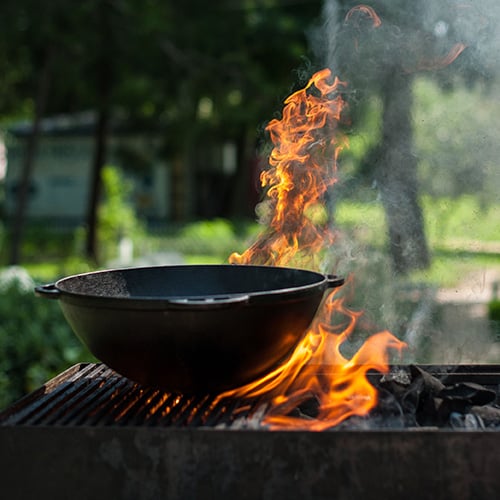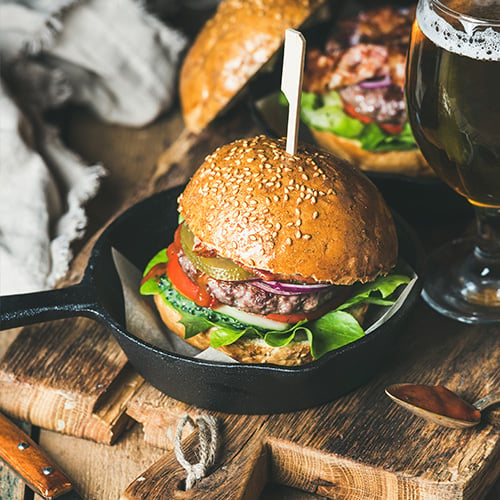Myths and Benefits of Cooking with Cast Iron
When you think of cast iron cookware, you probably picture a campfire. Maybe some cowboys out on the range, sizzling up some steaks while swapping tall tales of legendary heroes and lost loves. But while it’s true this material has very humble beginnings, there’s actually a lot of ways you can use cast iron – in a lot of places. You can even use cast iron in restaurants!
Now you’re probably thinking, “That can’t be true. It’s impractical to use a cast iron skillet in a restaurant.” But the truth is that this age-old material is becoming more and more popular for commercial settings. Let’s explore some of the benefits cast iron has to offer and some of the myths that prevent it from being used as widely as it could be.
Shop All Cast Iron CookwareMyths About Cast Iron
Can you use soap to clean cast iron?
Yes! This is probably one of the most common misconceptions about cast iron. While it’s true that cast iron pans do need to build up a coating in order to stay non-stick, using a little bit of dish soap won’t hurt anything. The more important thing to remember is to always dry your cast iron immediately after washing it. Otherwise, you run the risk of rust.
Another thing to keep in mind here is that routine re-seasoning is recommended. You should coat your pan with a thin layer of melted vegetable oil or shortening and bake it between 350-400 degrees Fahrenheit. That level of heat should kill any bacteria just as effectively as soap, if not more so. So while you can use soap to wash your cast iron pans, you don’t necessarily need to.

Can you use cast iron cookware for restaurants?
Yes. In fact, many restaurants love using cast iron cookware because (in most cases) you can both cook and serve in the same pan. One of the most common restaurant uses you might see are “sizzle platters” where fajita fillings (like steak and peppers) are brought out on sizzling hot cast iron platters, usually on top of a heat-resistant underliner made of wood or silicone.
Is cast iron expensive?
Because the process of creating cast iron cookware is relatively simple, it tends to be very affordable. And when you think of the cost of cast iron in relation to a comparable non-stick pan, you’ll find that cast iron is a very cost-effective option. That’s because while most non-stick surfaces cannot be repaired after they’ve been scratched, cast iron can be re-seasoned again and again to repair any damage. If a cast iron skillet is seasoned routinely, its lifespan will far exceed that of a typical non-stick pan.

My cast iron pan is rusty. Is it ruined?
No. If your cast iron cookware is showing signs of rust, simply remove the rusty layer with steel wool. Even a paste made of coarsely ground salt and water on a paper towel will do the trick. You can use anything that’s abrasive enough to scrape the rust off. Just make sure it’s non-toxic because you don’t want to risk any harmful chemicals leeching into the surface of your pan.
Does cast iron heat evenly?
Unfortunately, no. While it may seem like the thickness of cast iron would distribute heat well, this material is notorious for cold spots. The best way to ensure even cooking while using a cast iron pan is to heat it really well either on the stovetop or in the oven prior to use.
Can traces of iron get into my food?
Cooking acidic foods (like tomato sauce) in a cast iron pan is not recommended because acid can wear down the seasoned coating and is more likely to absorb iron into the food itself. Although it's nontoxic, these traces of iron can leave a metallic taste in your sauce. So if you find that a particular recipe comes out tasting like iron, consider the acid levels of the ingredients and try making that dish in a different pan.
Why Use Cast Iron?
Cast iron lasts forever
As mentioned above, one of the best things about cast iron cookware is that it’s extremely durable and can usually be repaired if scratched or damaged. So as long as your pan doesn’t chip or crack, you can remove any rust and re-season it again and again.

Cast iron is oven safe
Probably the best thing about cooking with cast iron is its versatility. This material can be used with pretty much any heat source—from open flame to induction. This, of course, includes use in commercial ovens.
Not only will you be able to enjoy the effect cast iron can provide for your baked mac and cheese and fruit cobblers, but you can also experience the convenience of a naturally non-stick surface for making eggs and more.
Cast iron is natural
Unlike some non-stick pan coatings, cast iron pans are generally made of 100% natural materials—namely iron and oil. This is a fantastic benefit for farm-to-table restaurants or any establishment that focuses on clean cooking and natural ingredients.
New features for cast iron are being developed
Companies like Lodge have been developing new techniques of manufacturing and treating cast iron that are healthier for factory workers and provide convenient qualities, like dishwasher-safe finishes. By combining ancient casting techniques with cutting-edge technology, Lodge has developed a heat-treated line of rust-resistant cast iron cookware. They cast these products using the same process they’ve been practicing for over 100 years. Then, they expose the items to a heating process that penetrates the outer layer of the pan, which deoxidizes the iron, making it resistant to rust. This means that, for the first time ever, you can actually clean your cast iron in the dishwasher! And even better yet, there are no harmful chemicals used to coat the surface of these products—just oil, and heat.
Since this technique is still so new, the number of rust-resistant products available is mostly limited to small, oven-to-table serving pieces. However, Lodge plans to expand their selection of heat-treated products in the near future.

Cast iron is a visually appealing presentation piece
Let’s not forget that the classic look of these products can contribute to an eye-catching presentation in a variety of settings. From country-themed restaurants to modern rustic establishments, customers love serving pieces made of natural materials that are designed with a classic appearance.
While you may have thought you knew everything there was to know about cast iron, keep in mind that this centuries-old material is still being developed in new ways to make it more practical for commercial environments. It’s durable enough to withstand scratches and other wear and tear, and versatile enough to be used with any heat source. And the introduction of rust-resistant products has opened even more doors for new possibilities at restaurants and in other commercial settings. So if you’re thinking of replacing your existing cookware (or stocking your restaurant for the very first time), consider incorporating cast iron into the mix.








